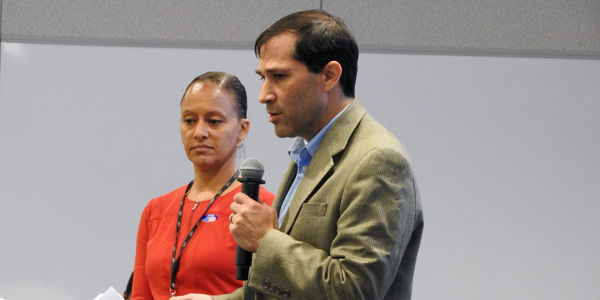VALLEY FORGE, Pa. — PJM’s Glen Boyle presented the Operating Committee last week with a proposed solution to address FERC’s proposed primary frequency response rule.
The proposal, which came from meetings of the Primary Frequency Response Senior Task Force, would rely on individual resources to provide the capability with specific performance settings; PJM doesn’t plan on requiring units to maintain operating headroom.
“We didn’t see need for that right now,” Boyle said.
PJM is considering either a cost-of-service payment, where the resource owner files with FERC for cost recovery for performing during an event, or determining that the frequency response capital investment is already included in the cost-of-new-entry (CONE) calculation. The focus comes in response to a 2012 NERC report found that only 30% of units were providing primary frequency response and a Notice of Proposed Rulemaking last year from FERC that would require all new units, excluding nuclear, to provide the service. (See FERC Has More Questions on Frequency Response NOPR.)
“As far as looking at a pure, market-based mechanism, that’s something that PJM would be open to, but we’ve had some difficulties with identifying what the actual requirement is, as it changes on a literally minute-by-minute basis,” Boyle said.
He also highlighted concerns about measuring units’ responsiveness. “So there are some pretty significant challenges to a market-based compensation,” he said. Tom Hyzinski of GT Power Group agreed it would be difficult to develop a market to compensate a minute-by-minute response.
Several generator representatives, including Hyzinski and Calpine’s David “Scarp” Scarpignato, balked at exempting certain technology types and not compensating frequency response beyond capacity payments. Hyzinski suggested developing a product based on a resource’s ability to provide the service.
“You can’t have resources that don’t provide primary frequency response participating in the same capacity market and taking the same capacity payment,” he said, questioning whether the capacity market currently compensates for the capability to provide frequency response.
“I think you’ll want to look at a way that, if they can’t provide it, they somehow purchase … it,” Scarp said.
“That is another option that’s still out there on the table,” Boyle acknowledged.
Scarp said frequency response is an element of resiliency, and “PJM is saying in a lot of forums that it wants to value resiliency.” He asked that PJM staff working on the frequency response issue engage with those focused on resiliency.
Restoration Drills
PJM’s Ryan Lifer reviewed the results of the annual fall restoration drills held recently. There were 108 transmission owner participants, 17 from generators and 47 PJM staffers, Lifer said.
User feedback was positive for a centralized website where participants could upload all information in one location, he said. PJM plans to complete the site in time for the annual spring restoration drill, which will be held May 15-16. Communications checks will happen on May 14. Alternate dates are set for May 21 through 23.
PJM Expects Cold Winter Season
System operators are planning for a colder winter this year than in the past two, PJM’s Augustine Caven said. Analysts expect a weak La Nina effect to develop, causing colder conditions, along with above-average precipitation in the Great Lakes region and below average to the south.
“Southward shifts in the polar vortex caused unusually cold weather this past August, and the expectation is that if this trend continues, we’re anticipating greater risk of arctic cold,” Caven said. “In short, we expect a significant cold winter season, and we’re taking steps to be prepared.”
TOs Must Approve PJM Licensing of DIMA
PJM wants to offer its Dispatcher Interactive Map Application (DIMA) to all TOs, but there’s a catch. Because DIMA requires some confidential TO information to work optimally, all TOs will have to sign off on the plan, and those that want to use it will have to sign nondisclosure agreements and pay PJM a licensing fee.
PJM’s Ed Kovler and Jacqui Hugee outlined the advantages, including compiling data from multiple resources into one geospatial display, and the requirements, which include several Operating Agreement changes.
PJM Holds Ground on Expanding ‘Hot Weather Alert’ Definition

PJM’s Chris Pilong said that the RTO still plans to revise its “Hot Weather Alert” definition to include lower temperatures “during the spring and fall periods if there are significant amounts of generation and transmission outages that reduce available generating capacity.”
The revisions, part of a periodic review of Manual 13, have sparked concern among stakeholders who feel the alert should be very narrowly defined.
“It seems like we’re taking a Hot Weather Alert and turning it into a ‘hot weather and warm weather/stuff is out’ alert,” said Adrien Ford of Old Dominion Electric Cooperative. “My question for you to consider is … should we consider making them separate?”
American Electric Power’s Brock Ondayko said he’s “still opposed” to the procedure PJM is trying to develop. He had initially voiced his opposition when Pilong announced it at October’s OC meeting. (See “Grid Operator Communications Changes Spark Debate,” PJM Operating Committee Briefs: Oct. 10, 2017.)
“I think there needs to be discussion,” he said.
— Rory D. Sweeney




